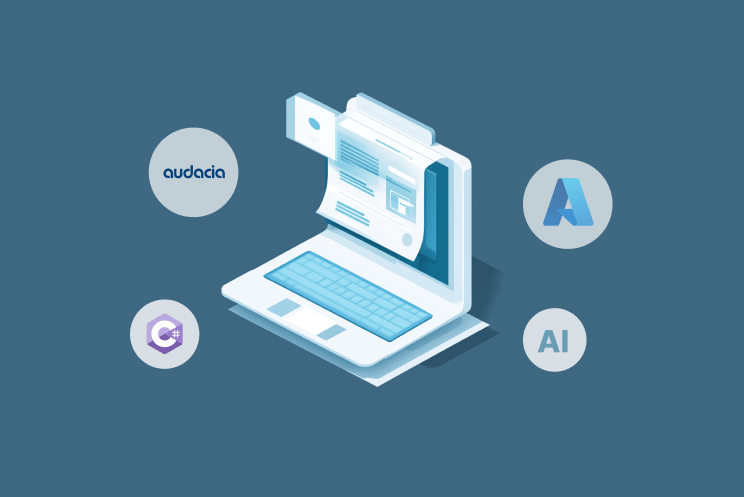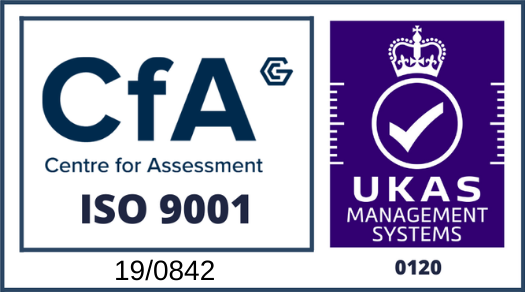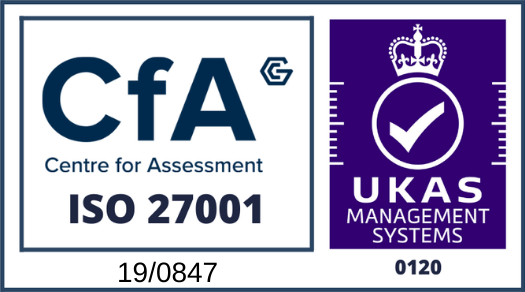This blog post has been adapted from this Tech Talk by Rhys Smith, Principal Software Engineer at Audacia.
For many businesses, documents are the backbone of daily operations. Yet manual processing of these documents can be slow, error-prone, and often risky when it comes to handling sensitive data. This article explores how Azure Document Intelligence helps organisations automate document workflows, improving speed, accuracy, and compliance. We’ll break down how it works, common use cases across industries, and real-world examples that show its measurable impact.
The Challenges of Manual Processing
Manual Data Entry is Time-Consuming
Documents are rarely uniform. Invoices, CVs, ID forms – each provider, applicant, or organisation tends to use their own template. Key fields might sit in completely different places. Because of this, human effort is required to read, interpret, and process the data. More complex documents (like multi-line invoices or detailed patient forms) take even longer, as people need to reason through related information to ensure it makes sense.
Manual Data Entry is Prone to Error
Human involvement naturally introduces mistakes. On average, manual data entry results in 100–400 errors per 10,000 data points – roughly a 1%–4% error rate. In comparison, automated document intelligence processes drop this to typically under 4 errors per 10,000. That’s close to a 10x improvement in accuracy. (DocuClipper, 2025)
Manual Processing Risks Exposing Sensitive Data
Many of the documents processed contain personal or sensitive information – names, addresses, dates of birth. In the context of GDPR and similar regulations, each manual touchpoint becomes a compliance risk. Relying on staff to handle and interpret this data increases the chance of mishandling, while automated systems offer auditable logs and stricter access controls by design.
Manual Processing Delays Decisions
The slower the data entry, the slower the business decision. For example, slow CV screening can result in losing top candidates. The same principle applies to onboarding new bank customers or processing healthcare claims. Automating data extraction means faster responses, which can be a competitive advantage.
Under the Hood: How Document Intelligence Works
Azure Document Intelligence works by transforming unstructured data (like PDFs, scans, or photos) into structured outputs you can feed into your systems.
The process is more sophisticated than simply applying OCR and hoping for the best. It’s built on a layered approach:
- OCR Layer (Optical Character Recognition)
Finds and groups text on the page – identifying where the text sits, breaking it into lines and characters. - Output Analysis Layer
Understands the document structure. Determines where tables, paragraphs, signatures, or images live on the page. - Semantic Parsing and Entity Extraction
Matches related text. For instance, links “Total Due” to “£300” by proximity and layout, building key-value pairs. - Classification
Pulls it all together to determine the type of document (invoice, ID card, CV) with a confidence score.
This layered approach means the system isn’t just blindly reading text – it’s learning relationships, understanding context, and determining what each document represents.
The Benefits of Azure Document Intelligence
Automation that Reduces Time and Cost
By automating the extraction of structured data from documents, Azure Document Intelligence significantly reduces the time people spend manually entering or verifying information. Instead of dedicating entire teams to data entry, businesses can shift to small groups who simply validate the extracted data – leading to lower operational costs.
Higher Accuracy than Manual Processing
Compared to the roughly 1%–4% error rate in manual entry, automated document intelligence systems typically improve accuracy 10x. This not only cuts down on costly mistakes but also builds confidence in the reliability of downstream workflows.
Faster Processing Speeds
An average data entry employee speed runs 10,000 to 15,000 keystrokes per hour, translating to between 60–100 simple documents a day, or only 10–12 highly complex documents. (DocuClipper, 2025) During testing, Azure processed simple documents in just 3–4 seconds, and more complex ones in 30 seconds to a minute. This could result in an enormous throughput increase.
Easy Integration into Existing Workflows
Most teams aren’t looking to rebuild their entire tech stack just to adopt document intelligence. Integrating Azure’s API with a .NET backend (or any mainstream stack) is straightforward. It slots into existing processes, allowing validation checks (like ensuring line items add up or matching customer IDs to records) before pushing data to finance, HR, or medical systems.
Use Cases Across Industries
Finance
- Invoice Processing & Validation
Instead of manual checks, the system extracts line items, totals, vendor names, and automatically verifies calculations – e.g. two £10 lines sum to £20. Validated invoices can flow straight into financial systems. - Risk Analysis for Account Openings
Digital KYC processes (uploading ID, proof of address) can be automated. Extraction models pull out names, addresses, dates, and cross-verify them–similar to what many banks like Revolut have automated.
Human Resources
- Resume Screening
Given the volume of CVs, manual screening is a bottleneck. Using AI to extract years of experience, tech stacks, or certifications means faster filtering. - Employee Onboarding
Automate the capture of IDs or compliance forms (like DBS checks) needed to get new hires ready.
Healthcare
- Patient Intake Forms
Scan handwritten or printed forms, match them to existing medical records, flag related history – streamlining check-ins and freeing up admin staff. - Digitising Records
NHS and others are actively exploring scanning decades of paper records into digital systems, applying similar techniques.
Proven Impact: A Few Real-World Examples
Volvo (Automotive)
Saved 10,000 manual work hours by deploying Azure Document Intelligence for invoices and claims, starting from a 6-week pilot before a 4-month wider rollout. (Microsoft, 2023)
Fujitsu (Communications)
Improved character recognition accuracy from 96% on handwritten text to 99.9% after integrating document intelligence–cutting error rates dramatically. (Microsoft, 2022)
Unilever (HR)
Used AI to scan over 250,000 resumes, saving ~50,000 hours of recruiter time. At ~20 min spent per manual CV review; the scale of savings is obvious. (Hirevire, 2025; Wikipedia)
Omega Health (Insurance/Healthcare)
Reduced claim processing time by 50%, saving around 15,000 employee hours per month, with extraction accuracy at 99.5%. (Business Insider, 2025)
Compliance and Security Aren’t Optional
Any workflow involving personal data needs to be airtight. Azure’s ecosystem is designed with compliance in mind:
GDPR Compliance & Retention Policies
Automate deletion of sensitive data after regulatory periods (e.g. 7 years).
Encryption & Role-Based Access
Data is encrypted at rest. Fine-grained access control means you decide who can view, upload, or process documents.
Audit Trails & Logging
Integrated with tools like App Insights and Sentinel to trace who accessed what and when – essential for forensic investigations or audits.
For industries with ISO standards or equivalent accreditations, these controls are critical to avoid lapses.
Live Demo
Wrapping Up
Whether you’re tackling financial compliance, speeding up hiring, or modernising patient record systems, automating document processing with Azure Document Intelligence unlocks significant efficiencies.
Success hinges on three principles:
- Consistent training data. Ensure you label fields uniformly across samples to teach the model reliably.
- Training samples over training time. Based on practical tests, going from 5 to 50 documents with consistent labels improved extraction performance dramatically, while longer training on a small set had negligible impact.
- Clear process design. Use validation rules that make business sense–e.g. checking invoice totals or required skills on resumes.
The combination of reduced error rates, faster throughput, and stronger security makes this a compelling area for technical leaders to explore. It’s not just about cost–it’s about freeing up talented teams to focus on the work that truly needs human judgement.


